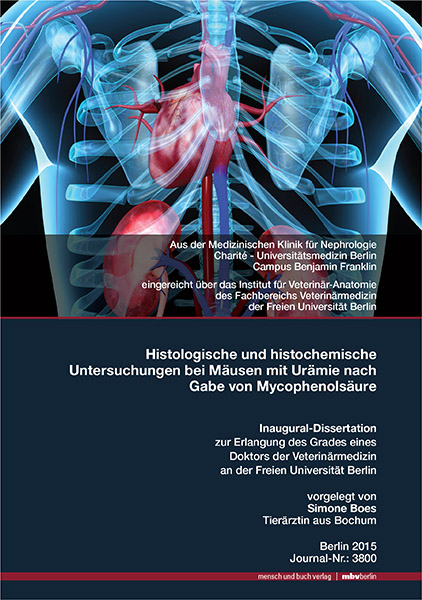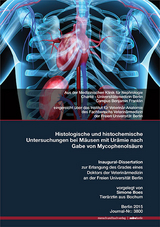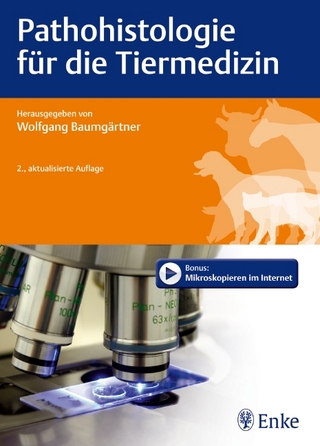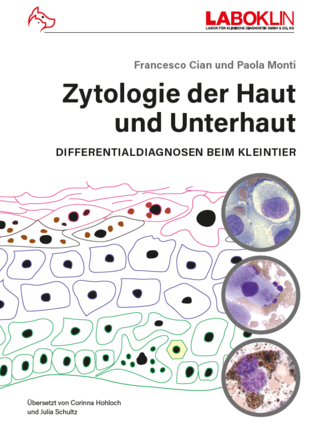Histologische und histochemische Untersuchungen bei Mäusen mit Urämie nach Gabe von Mycophenolsäure
Seiten
2015
|
1. Aufl.
Mensch & Buch (Verlag)
978-3-86387-661-6 (ISBN)
Mensch & Buch (Verlag)
978-3-86387-661-6 (ISBN)
- Keine Verlagsinformationen verfügbar
- Artikel merken
Hintergrund und Zielsetzung:
Kardiovaskuläre Erkrankungen mit vaskulärer Kalzifizierung stellen ein klinisches Problem bei der chronischen Niereninsuffizienz (CKD) sowie bei der Nierentransplantation beim Menschen dar. In Voruntersuchungen konnte im Zellmodell ein hemmender Einfluss von Mycophenolsäure (MPA) auf die Kalzifizierung von glatten Gefäßmuskelzellen nachgewiesen werden. Das Ziel dieser Arbeit war es, die sich aus der Voruntersuchung ergebende, potentielle anti-kalzifizierende Wirkung von MPA im Tiermodell zu verifizieren. MPA ist ein nicht-kompetitiver und reversibler Inhibitor der Inosinmonophosphat-Dehydrogenase, wodurch die Proliferation der T- und B- Lymphozyten gehemmt wird. Neben diesen immunsuppressiven Eigenschaften von MPA, wird der oben genannte Einfluss auf das kardiovaskuläre System vermutet.
Methoden:
Zur Induktion einer CKD im Tiermodell wurden nacheinander zwei Nephrektomien durchgeführt. Bei der ersten Operation wurden 75 % der rechten Niere indirekt durch Abbinden der Gefäße teilnephrektomiert. Bei der zweiten Operation wurde die linke Niere vollständig entfernt. Während der zweiten Operation wurde auch die osmotische Pumpe mit MPA am Rücken subkutan implantiert. Drei Tage später erfolgte eine Futterumstellung auf eine Hochphosphatdiät bei allen Versuchstieren, da ein hoher Phosphatanteil im Futter für die Entwicklung einer Kalzifizierung notwendig ist. Es wurden weibliche DBA/2 Mäuse in vier Gruppen eingeteilt. Bei der Kontrollgruppe wurden keine Nephrektomien, sondern lediglich zwei Scheinoperationen ohne nachfolgende Medikation durchgeführt. Bei der Lösungsmittelgruppe wurden zwar Nephrektomien durchgeführt, aber anstelle von MPA nur Lösungsmittel verabreicht. Bei der low dose-MPA und bei der high dose MPA-Gruppe wurden ebenfalls Nephrektomien durchgeführt. Der low dose MPAGruppe wurde anschließend 3 mg/kg KGW/Tag MPA, der high dose MPA-Gruppe 30 mg/kg KGW/Tag MPA, jeweils in Lösungsmittel, verabreicht. Blutentnahmen fanden jeweils am Versuchsbeginn und -ende statt. Parathormon wurde mittels ELISA bestimmt. Eine Parathormondysbalance kann auf eine Störung des Kalzium- und Phoshathaushalts hinweisen. Ferner wurden Harnstoff-Stickstoff, alkalische Phosphatase, Gesamtcholesterin, Kalzium und anorganisches Phosphat via Trockenchemie ermittelt. Die rechte Niere und das Herz wurden histologisch mit Hilfe einer Hämatoxylin-, Von Kossa- und Alizarinrot S-Färbung untersucht. Außerdem erfolgten eine Bestimmung der Herznassgewichte sowie die biochemische Bestimmung des kardialen Kalziumgehaltes in den Proben.
Ergebnisse:
Die Niereninsuffizienz wurde mittels Nephrektomie und Hochphoshatdiät erfolgreich induziert. Für Parathormon und Harnstoff-Stickstoff konnte in der Lösungsmittelgruppe ein Anstieg gemessen werden. Es bildete sich in allen vier Gruppen ein sekundärer Hyperparathyreoidismus aus und auch der Kalzium- und der anorganische Phosphathaushalt waren gestört. Beide MPA-Gruppen zeigten eine Verminderung von Harnstoff-Stickstoff und alkalischer Phosphatase im Blutplasma im Vergleich zur Lösungsmittelgruppe. Das Herz war bei der Lösungsmittelgruppe signifikant kalzifiziert gegenüber der Kontrollgruppe (Alizarinrot S-Färbung, Herzgewicht, Histomorphometrie, biochemische Kalziumbestimmung). Der kardiale biochemische Kalziumgehalt der low dose MPA-Gruppe war geringer als bei der Lösungsmittelgruppe. Die kardiale Verkalkung der high dose MPA-Gruppe war in allen Untersuchungen im Vergleich zur Lösungsmittelgruppe und auch zur low dose MPA-Gruppe vermindert.
Schlussfolgerung:
MPA hat anti-kalzifizierende Eigenschaften, da sie im Tierversuch die Kalziumablagerungen im Myokard vermindern konnte. Dies könnte therapeutische Möglichkeiten bei kardiovaskulären Erkrankungen eröffnen. - Histological and histochemical investigations in uremic mice after administration of mycophenolic acid -
Background and aim:
Cardiovascular diseases with vascular calcification represent a common clinical problem for human patients with chronic kidney disease (CKD) and those having undergone renal transplantation. Preliminary studies verified that mycophenolic acid (MPA) has an inhibitive effect on the calcification of smooth muscle cells in vitro. The aim of this study is to verify the anti-calcifying impact of MPA in the animal model. MPA is a noncompetitive and reversible inhibitor of the inosinmonophosphate-dehydrogenase, which prevents proliferation of T- and B lymphocytes. In addition to the immunosuppressive characteristics of MPA, an anti-calcifying effect on the cardiovascular system could be suspected.
Methods:
In order to induce CKD in the animal model, nephrectomies were conducted in two steps. During the first operation 75 % of the right kidney was nephrectomised by ligature. During the second operation the left kidney was completely removed and the osmotic pump with MPA was subcutaneously implanted into the back. Three days later a high phosphate diet was induced to all animals, because a high level of phosphate in the diet is necessary to develop a calcification. Female DBA/2 mice were split into four groups. The animals of the control group had no nephrectomies, only two sham operations without any medication were done. In the solvent group two operations were carried out, without MPA. In the low dose and a high dose MPA group nephrectomies were carried out. To the low dose MPA group 3 mg/kg body weight/per day of MPA was given. The high dose MPA group received 30 mg/kg body weight/per day of MPA. In both cases MPA was administered in a solvent. Blood samples were taken at the beginning and at the end of the trial. The level of parathyroid hormone was measured with ELISA. A parathyroid hormone dysbalance may point to a disturbance of the calcium and phosphate metabolism. In addition alkaline phosphatase, urea, total cholesterol, calcium and inorganic phosphate were analyzed with dry chemistry. The right kidney and the heart were examined histologically with hematoxylin, von Kossa and alizarin red S staining. In addition the heart wet weights and the calcium content of the hearts were measured biochemically and histomorphometricly.
Results:
A renal failure was successfully induced by nephrectomy and high phosphate diet. In the solvent group an increase of parathyroid hormone and urea was detected. All four groups showed the development of secondary hyperparathyroidism, while the calcium and inorganic phosphate metabolism was disturbed. Urea and inorganic phosphate in blood plasma were decreased in both MPA groups compared to the solvent group. Furthermore, the heart was significantly calcified in the solvent group than in the control group (alizarin red S staining, heart wet weight, histomorphometry, biochemical calcium content). In the low dose MPA group, the biochemical calcium content of the heart was lower compared to the solvent group. In the high dose MPA group all measurements showed a decrease in cardiac calcification compared with the solvent and with the low dose MPA group.
Conclusion:
MPA has anti-calcifying properties, since it decreases the calcium content in the myocardium, as shown in the animal model. This finding could have a beneficial impact on the therapy of cardiovascular diseases.
Kardiovaskuläre Erkrankungen mit vaskulärer Kalzifizierung stellen ein klinisches Problem bei der chronischen Niereninsuffizienz (CKD) sowie bei der Nierentransplantation beim Menschen dar. In Voruntersuchungen konnte im Zellmodell ein hemmender Einfluss von Mycophenolsäure (MPA) auf die Kalzifizierung von glatten Gefäßmuskelzellen nachgewiesen werden. Das Ziel dieser Arbeit war es, die sich aus der Voruntersuchung ergebende, potentielle anti-kalzifizierende Wirkung von MPA im Tiermodell zu verifizieren. MPA ist ein nicht-kompetitiver und reversibler Inhibitor der Inosinmonophosphat-Dehydrogenase, wodurch die Proliferation der T- und B- Lymphozyten gehemmt wird. Neben diesen immunsuppressiven Eigenschaften von MPA, wird der oben genannte Einfluss auf das kardiovaskuläre System vermutet.
Methoden:
Zur Induktion einer CKD im Tiermodell wurden nacheinander zwei Nephrektomien durchgeführt. Bei der ersten Operation wurden 75 % der rechten Niere indirekt durch Abbinden der Gefäße teilnephrektomiert. Bei der zweiten Operation wurde die linke Niere vollständig entfernt. Während der zweiten Operation wurde auch die osmotische Pumpe mit MPA am Rücken subkutan implantiert. Drei Tage später erfolgte eine Futterumstellung auf eine Hochphosphatdiät bei allen Versuchstieren, da ein hoher Phosphatanteil im Futter für die Entwicklung einer Kalzifizierung notwendig ist. Es wurden weibliche DBA/2 Mäuse in vier Gruppen eingeteilt. Bei der Kontrollgruppe wurden keine Nephrektomien, sondern lediglich zwei Scheinoperationen ohne nachfolgende Medikation durchgeführt. Bei der Lösungsmittelgruppe wurden zwar Nephrektomien durchgeführt, aber anstelle von MPA nur Lösungsmittel verabreicht. Bei der low dose-MPA und bei der high dose MPA-Gruppe wurden ebenfalls Nephrektomien durchgeführt. Der low dose MPAGruppe wurde anschließend 3 mg/kg KGW/Tag MPA, der high dose MPA-Gruppe 30 mg/kg KGW/Tag MPA, jeweils in Lösungsmittel, verabreicht. Blutentnahmen fanden jeweils am Versuchsbeginn und -ende statt. Parathormon wurde mittels ELISA bestimmt. Eine Parathormondysbalance kann auf eine Störung des Kalzium- und Phoshathaushalts hinweisen. Ferner wurden Harnstoff-Stickstoff, alkalische Phosphatase, Gesamtcholesterin, Kalzium und anorganisches Phosphat via Trockenchemie ermittelt. Die rechte Niere und das Herz wurden histologisch mit Hilfe einer Hämatoxylin-, Von Kossa- und Alizarinrot S-Färbung untersucht. Außerdem erfolgten eine Bestimmung der Herznassgewichte sowie die biochemische Bestimmung des kardialen Kalziumgehaltes in den Proben.
Ergebnisse:
Die Niereninsuffizienz wurde mittels Nephrektomie und Hochphoshatdiät erfolgreich induziert. Für Parathormon und Harnstoff-Stickstoff konnte in der Lösungsmittelgruppe ein Anstieg gemessen werden. Es bildete sich in allen vier Gruppen ein sekundärer Hyperparathyreoidismus aus und auch der Kalzium- und der anorganische Phosphathaushalt waren gestört. Beide MPA-Gruppen zeigten eine Verminderung von Harnstoff-Stickstoff und alkalischer Phosphatase im Blutplasma im Vergleich zur Lösungsmittelgruppe. Das Herz war bei der Lösungsmittelgruppe signifikant kalzifiziert gegenüber der Kontrollgruppe (Alizarinrot S-Färbung, Herzgewicht, Histomorphometrie, biochemische Kalziumbestimmung). Der kardiale biochemische Kalziumgehalt der low dose MPA-Gruppe war geringer als bei der Lösungsmittelgruppe. Die kardiale Verkalkung der high dose MPA-Gruppe war in allen Untersuchungen im Vergleich zur Lösungsmittelgruppe und auch zur low dose MPA-Gruppe vermindert.
Schlussfolgerung:
MPA hat anti-kalzifizierende Eigenschaften, da sie im Tierversuch die Kalziumablagerungen im Myokard vermindern konnte. Dies könnte therapeutische Möglichkeiten bei kardiovaskulären Erkrankungen eröffnen. - Histological and histochemical investigations in uremic mice after administration of mycophenolic acid -
Background and aim:
Cardiovascular diseases with vascular calcification represent a common clinical problem for human patients with chronic kidney disease (CKD) and those having undergone renal transplantation. Preliminary studies verified that mycophenolic acid (MPA) has an inhibitive effect on the calcification of smooth muscle cells in vitro. The aim of this study is to verify the anti-calcifying impact of MPA in the animal model. MPA is a noncompetitive and reversible inhibitor of the inosinmonophosphate-dehydrogenase, which prevents proliferation of T- and B lymphocytes. In addition to the immunosuppressive characteristics of MPA, an anti-calcifying effect on the cardiovascular system could be suspected.
Methods:
In order to induce CKD in the animal model, nephrectomies were conducted in two steps. During the first operation 75 % of the right kidney was nephrectomised by ligature. During the second operation the left kidney was completely removed and the osmotic pump with MPA was subcutaneously implanted into the back. Three days later a high phosphate diet was induced to all animals, because a high level of phosphate in the diet is necessary to develop a calcification. Female DBA/2 mice were split into four groups. The animals of the control group had no nephrectomies, only two sham operations without any medication were done. In the solvent group two operations were carried out, without MPA. In the low dose and a high dose MPA group nephrectomies were carried out. To the low dose MPA group 3 mg/kg body weight/per day of MPA was given. The high dose MPA group received 30 mg/kg body weight/per day of MPA. In both cases MPA was administered in a solvent. Blood samples were taken at the beginning and at the end of the trial. The level of parathyroid hormone was measured with ELISA. A parathyroid hormone dysbalance may point to a disturbance of the calcium and phosphate metabolism. In addition alkaline phosphatase, urea, total cholesterol, calcium and inorganic phosphate were analyzed with dry chemistry. The right kidney and the heart were examined histologically with hematoxylin, von Kossa and alizarin red S staining. In addition the heart wet weights and the calcium content of the hearts were measured biochemically and histomorphometricly.
Results:
A renal failure was successfully induced by nephrectomy and high phosphate diet. In the solvent group an increase of parathyroid hormone and urea was detected. All four groups showed the development of secondary hyperparathyroidism, while the calcium and inorganic phosphate metabolism was disturbed. Urea and inorganic phosphate in blood plasma were decreased in both MPA groups compared to the solvent group. Furthermore, the heart was significantly calcified in the solvent group than in the control group (alizarin red S staining, heart wet weight, histomorphometry, biochemical calcium content). In the low dose MPA group, the biochemical calcium content of the heart was lower compared to the solvent group. In the high dose MPA group all measurements showed a decrease in cardiac calcification compared with the solvent and with the low dose MPA group.
Conclusion:
MPA has anti-calcifying properties, since it decreases the calcium content in the myocardium, as shown in the animal model. This finding could have a beneficial impact on the therapy of cardiovascular diseases.
| Erscheinungsdatum | 12.01.2018 |
|---|---|
| Verlagsort | Berlin |
| Sprache | deutsch |
| Themenwelt | Veterinärmedizin ► Vorklinik ► Histologie / Embryologie |
| Veterinärmedizin ► Klinische Fächer ► Versuchstiere | |
| Schlagworte | Animal Models • calcification • Cardiovascular Diseases • heart • Histology • mice • uraemia |
| ISBN-10 | 3-86387-661-X / 386387661X |
| ISBN-13 | 978-3-86387-661-6 / 9783863876616 |
| Zustand | Neuware |
| Informationen gemäß Produktsicherheitsverordnung (GPSR) | |
| Haben Sie eine Frage zum Produkt? |
Mehr entdecken
aus dem Bereich
aus dem Bereich
Differentialdiagnosen beim Kleintier
Buch | Softcover (2023)
LABOKLIN GmbH & Co. KG (Verlag)
55,95 €
Grundlagen, Techniken, Präparate
Buch | Hardcover (2019)
Schlütersche (Verlag)
59,95 €




